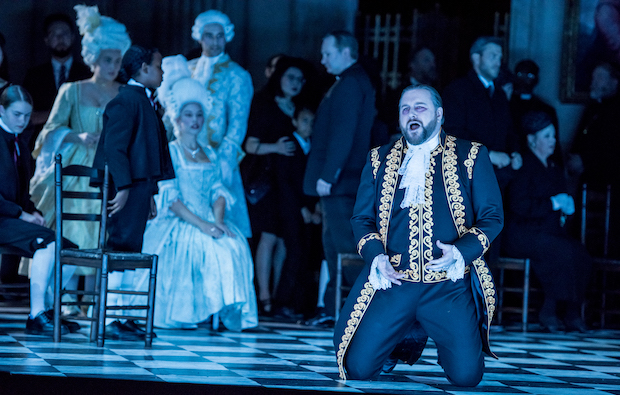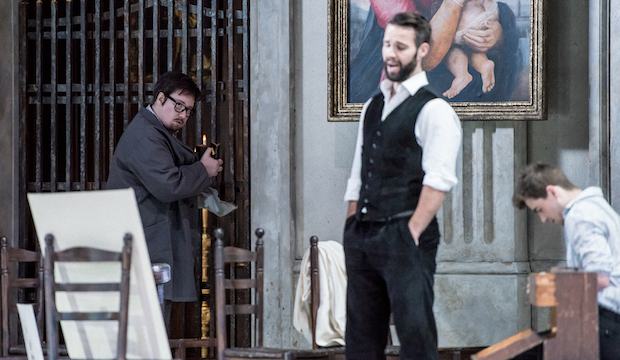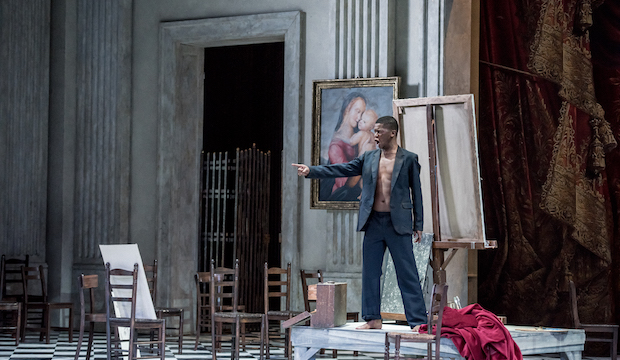Tosca, English National Opera review ★★★★★
ENO's 2022/23 season opens with a new production of Puccini's dramatic opera. A singer and an artist find themselves up against a bully...
Tosca resists predatory Scarpia in Puccini's opera. Photo: Genevieve Girling
Set in 1800, premiered in 1900, opening the 2022/23 season at English National Opera, Puccini’s Tosca is an opera for all times. At its heart, a powerful man who takes advantage of his authority to control and seduce a woman, and a desperate act that denies him satisfaction.
In the first of three new ENO productions this autumn, director Christof Loy stresses the timelessness of heroine Tosca’s plight by hinting at other ages still, with ghostly figures from the mid-1700s picking their way through the action in a church and a palace whose 16th-century architecture is recreated by designer Christian Schmidt. Tosca and townspeople first appear in 1950s suits and frocks.
BOOK HERE
Floria Tosca is a celebrity opera singer in Rome at a time of political turmoil. Her lover, the painter Mario Cavaradossi, is sheltering an escaped activist, at great risk. Ever watchful is the predatory chief of police, Baron Scarpia, who trades Mario’s life for Tosca’s honour, and then double-crosses her.

Christof Loy's Tosca blends the 1750s and the 1950s. Photo: Genevieve Girling
Soprano Sinéad Campbell-Wallace is Tosca, bringing great rationality as well as passion to the role which she sings magnificently. It is Scarpia, crazed by lust and insecurity, who loses his wits. American baritone Noel Bouley, unable to sing on first night, acted the role with heroic Roland Wood voicing Scarpia from the side of the stage.
Difficult to weigh up that performance then, but Loy has Scarpia writhing in a frenzy of desire in the Act I scene in the church of Sant’ Andrea della Valle. Was this an implausible loss of control in public? Or was this only happening in Scarpia’s head?
Puccini writes some of the most chilling music in all opera to herald Scarpia. We know he is a villain without his paws everywhere. The aria that should stop time, Tosca’s heartbroken aria, originally 'Vissi d’arte', here in Edmund Tracey's English translation 'Love and music...', while movingly sung by Campbell-Wallace was undermined by Scarpia’s wandering hands.

Painter Mario Cavaradossi (Adam Smith) surveys his work. Photo: Genevieve Girling
Tenor Adam Smith is a rangy Cavaradossi, and there is fine singing in the minor roles, notably from bass Msimelelo Mbali as escaped prisoner Angelotti and bass-baritone Ossian Huskinson as police agent Sciarrone.
Loy, directing at ENO for the first time, introduces further distractions. A stagey painted curtain creeps in and out of the action, almost suggesting that what is happening is only artifice, which is very odd when the action is so real. And Act III gets off to a very slow start with a dull scene in a prison cell, where a shepherd boy’s pastoral song is damped down into an hallucination and Mario’s hymn to life is robbed of the glow before dawn.
Leo Hussain conducting the orchestra and chorus of English National Opera, on the ball as ever, has animated back-up from London children in the Act I act of worship.

Bass Msimelelo Mbali is impressive as Angelotti. Photo: Genevieve Girling
For all the oddities here, Tosca feels as indestructible as the Roman landmarks in which it is set, and its relevance to persecuted women undiminished. Audience members enjoying ENO’s free tickets for under-21s will live to see in the 22nd century. Perhaps by then the Toscas of this world will have been able to go about their lives unmolested.
Tosca is sung in English with English surtitles. It is a co-production with Finnish National Opera and Ballet. For tickets click here. Further performances are on 3, 5, 8, 10, 13, 15, 19, 22, 27 and 29 Oct; 2, 4 Nov
In the first of three new ENO productions this autumn, director Christof Loy stresses the timelessness of heroine Tosca’s plight by hinting at other ages still, with ghostly figures from the mid-1700s picking their way through the action in a church and a palace whose 16th-century architecture is recreated by designer Christian Schmidt. Tosca and townspeople first appear in 1950s suits and frocks.
BOOK HERE
Floria Tosca is a celebrity opera singer in Rome at a time of political turmoil. Her lover, the painter Mario Cavaradossi, is sheltering an escaped activist, at great risk. Ever watchful is the predatory chief of police, Baron Scarpia, who trades Mario’s life for Tosca’s honour, and then double-crosses her.

Christof Loy's Tosca blends the 1750s and the 1950s. Photo: Genevieve Girling
Soprano Sinéad Campbell-Wallace is Tosca, bringing great rationality as well as passion to the role which she sings magnificently. It is Scarpia, crazed by lust and insecurity, who loses his wits. American baritone Noel Bouley, unable to sing on first night, acted the role with heroic Roland Wood voicing Scarpia from the side of the stage.
Difficult to weigh up that performance then, but Loy has Scarpia writhing in a frenzy of desire in the Act I scene in the church of Sant’ Andrea della Valle. Was this an implausible loss of control in public? Or was this only happening in Scarpia’s head?
Puccini writes some of the most chilling music in all opera to herald Scarpia. We know he is a villain without his paws everywhere. The aria that should stop time, Tosca’s heartbroken aria, originally 'Vissi d’arte', here in Edmund Tracey's English translation 'Love and music...', while movingly sung by Campbell-Wallace was undermined by Scarpia’s wandering hands.

Painter Mario Cavaradossi (Adam Smith) surveys his work. Photo: Genevieve Girling
Tenor Adam Smith is a rangy Cavaradossi, and there is fine singing in the minor roles, notably from bass Msimelelo Mbali as escaped prisoner Angelotti and bass-baritone Ossian Huskinson as police agent Sciarrone.
Loy, directing at ENO for the first time, introduces further distractions. A stagey painted curtain creeps in and out of the action, almost suggesting that what is happening is only artifice, which is very odd when the action is so real. And Act III gets off to a very slow start with a dull scene in a prison cell, where a shepherd boy’s pastoral song is damped down into an hallucination and Mario’s hymn to life is robbed of the glow before dawn.
Leo Hussain conducting the orchestra and chorus of English National Opera, on the ball as ever, has animated back-up from London children in the Act I act of worship.

Bass Msimelelo Mbali is impressive as Angelotti. Photo: Genevieve Girling
For all the oddities here, Tosca feels as indestructible as the Roman landmarks in which it is set, and its relevance to persecuted women undiminished. Audience members enjoying ENO’s free tickets for under-21s will live to see in the 22nd century. Perhaps by then the Toscas of this world will have been able to go about their lives unmolested.
Tosca is sung in English with English surtitles. It is a co-production with Finnish National Opera and Ballet. For tickets click here. Further performances are on 3, 5, 8, 10, 13, 15, 19, 22, 27 and 29 Oct; 2, 4 Nov
TRY CULTURE WHISPER
Receive free tickets & insider tips to unlock the best of London — direct to your inbox
| What | Tosca, English National Opera review |
| Where | English National Opera, London Coliseum, St Martin's Lane, London, WC2N 4ES | MAP |
| Nearest tube | Embankment (underground) |
| When |
30 Sep 22 – 04 Nov 22, 13 performances. Start times vary; running time 2hr 40min including interval |
| Price | £10-£160 |
| Website | Click here for more information and booking |